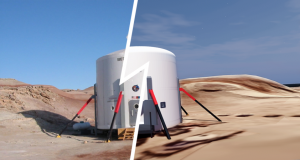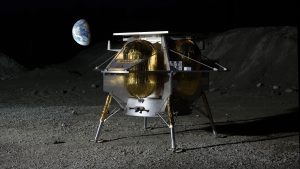Why Bother With Mars, Anyway?
 Mars is a hot topic among space enthusiasts these days. Mars One was always a long shot but I never really thought it was a deliberate scam. The funding seems to be the hard part when it comes to executing a complex project like this, but they might still pull it off if Bas Lansdorp could just get some investors lined up. Mars One has already done a good thing by getting people talking about manned missions to Mars and the recent upswing in interest that it generated has forced NASA to start getting serious about sending people to Mars.
Mars is a hot topic among space enthusiasts these days. Mars One was always a long shot but I never really thought it was a deliberate scam. The funding seems to be the hard part when it comes to executing a complex project like this, but they might still pull it off if Bas Lansdorp could just get some investors lined up. Mars One has already done a good thing by getting people talking about manned missions to Mars and the recent upswing in interest that it generated has forced NASA to start getting serious about sending people to Mars.
One thing I’ve noticed, though, is that not all space enthusiasts agree on the best way to reach Mars or even if we should even do Mars right away. Should we go back to the Moon first and maybe establish a few good lunar settlements, do the asteroid thing, make a pit stop on Deimos or Phobos first, or just go directly to Mars? And why should we do Mars at all?
What’s Next For Human Spaceflight: The Debate In Two Parts
Who Wants To Go To Mars, Anyhow?
Ask any of the “Mars 100” who are still in the running. I’ve interviewed quite a few of them for my Youtube channel and the one thing they seem to have in common is a real enthusiasm for what an organization like Mars One could do. Lennart Lopin created a cryptocurrency called Marscoin specifically to help fund Mars One and donated $10,000 worth of Marscoin each to Mars One and the Mars Society, for instance. These people are really serious about going to Mars.
Lennart Lopin and Marscoin
Mars One isn’t the only organization with skin in the game. Elon Musk has gone on record as saying that he’d like to get the cost of establishing a Martian colony down to $500,000 a person. Now Richard Branson has said that he’d like to get involved with a manned Mars project. Branson isn’t even being greedy about it. Even though this might seem to put him in direct competition with SpaceX as far as Mars is concerned, he joked to Mashable that he wouldn’t mind dividing the planet with the obvious rival. “Mars is a big place. … There’s room for us both.”
Somebody in the Mars community could create a country music parody about being into Mars before it was cool. Proposals for a manned Mars mission date back to Wernher von Braun’s Marsprojekt. Mercury astronaut Gordon Cooper thought that he might get to command a mission to Mars during the glory days of NASA. More recently, Mars Society president Robert Zubrin created the Mars Direct plan as a relatively affordable alternative to the proposed Mars mission in the 90-Day Report that turned out to be too expensive for Congress to swallow. This was at a time when NASA, having been burned by rebuffs from Congress, deemed any discussion of Mars missions beyond some robotic probes to be a toxic topic. Even so, he convinced some NASA senior officials that Mars missions could be done in a more cost-effective manner.
At the time of this writing, NASA has recently announced that they will be accepting applicants for a new astronaut class whose members might be among the first to stand on Mars starting on December 15, 2015. Do you have the right stuff?
The Mars Underground
Challenges Involved In Getting People To Mars
The Funding
I list funding first because this is the difficult part no matter how you cut it. Government agencies like NASA rely on the whims of a Congress who has no real incentive to provide funding. Americans spend more per capita on our pets than we do on NASA. As private organizations like Mars One are finding out, funding a private space effort is tough. As Robert Zubrin told me during an interview we did in September, the Mars Society is interested in borrowing some ideas from Inspiration Mars, which seems to be inactive due to lack of funding, for a project it calls Gemini Mars.
Interview with Robert Zubrin
Mars One’s original idea of funding a Martian settlement by snagging some advertising revenue and selling merchandise could be feasible if we could just find a friendly audience. One might wish that the Mars Society could tie its Youtube account to a Google Adsense account and turn on advertising so that it can snag some residual income every year. I hate to feel like I’m beating the same old drum, but considering that some marketing departments have budgets of more than $1 billion, I could give manned Mars missions a good shove in the right direction just by getting one blog entry or Youtube video to go viral and then donating the revenue it would generate to an organization that could actually pull it off. You’d be surprised by how much you can earn by helping Orion sell a few good telescopes.
Anytime you buy something on Amazon that you would have bought anyway, go to Amazon Smile and choose the Mars Society as your charity so that Amazon donates 0.5% of the purchase price to the Mars Society. Every little bit helps.
The Human Factor
Topics to cover might include fitness, food, the overall health of the astronauts, and the question of who we should even send if we send anyone at all. We could cover fitness with many of the same exercise machines that they use on the International Space Station and a few kettleballs and exercise bands for use on the Martian surface. How much cargo space could we allow for fitness equipment?
Sunita Williams Participates In A Triathlon In Space
How do you provide a diet that’s varied enough to keep the crew interested and provide needed nutrition? Anyone who has read The Martian may think that potatoes are obvious. In fact, potatoes became an Irish staple because they’re pretty easy to grow and provide a decent amount of calories per acre. Our Martians could stick a rack of mushrooms in a dark corner and give them a UV light to produce Vitamin D. Most of us don’t think of dandelions as being edible, but these tenacious little buggers multiply fast and could provide nutrients like Vitamins A, C and K. 3D printers could provide treats like pancakes and pizza. They’re getting better at creating vat-grown meats, though I still think grasshoppers are a viable option if you care about efficient creation of proteins that can live off the plant waste out of your greenhouse.
Doug Turnbull Discusses Food In Space
Your astronauts will probably start out healthy as a stable full of top-notch racehorses but they probably won’t stay that way. Long-duration missions usually weaken the immune system, making astronauts more vulnerable to illness even when you think they didn’t bring too many germs along. Somebody could break a leg by falling into a sandpit during an EVA on Mars. Even when you have a couple of pretty good medics on your team, you could lose someone to an injury or illness that would have been very treatable on Earth. This doesn’t mean we wait until we can establish a hospital with a good trauma center on Mars. It just means we send people who can keep the risk to a manageable level and know what to look for if somebody might be coming down with an illness.
Who should we send, anyway? When you’re sending a team, you want to send people who are pretty compatible and can stand looking at each other for possibly several years depending on the type of mission. Mars One’s criteria looks pretty accurate for a group effort. You want people who are pretty tolerant, have a sense of humor, can handle unexpected events and the occasional difference of opinion, and can roll up their sleeves and get clever when they have to “science the shit out of this” and solve problems.
Living on Mars: Dress Rehearsals at the Mars Desert Research Station
Actually Living On Mars
So you’ve made it to Mars without getting zapped by that solar flare and piled a few meters of regolith on top of your hab. The rush is beginning to wear off. Now what?
Now you settle in for the long haul. If you were smart, you didn’t choose the mission model that sticks you with only 30 days on Mars. That doesn’t mean you should slack off. That time will fly by faster than you think if you stay busy. Keep in mind that the nearest help is millions of miles away and won’t get to you quickly. Be prepared for a radio delay of up to 40 minutes when you tell Houston that you have a problem.
People talk about all the ways that Mars could kill you and most of them boil down to two things: your air and your heat. If you mess up on an EVA, you could freeze or asphyxiate or both. If you don’t have a backup power supply and your primary power source fails, you’re probably going to freeze unless you can repair it in time. If your airlock suddenly turns into an explosive projectile, you and your potato plants freeze and asphyxiate. Watney was lucky; he was in his pressure suit and he had duct tape on hand.
A side note: Dust storms usually don’t feel much worse than a good breeze on Earth and certainly won’t knock over your MAV. If it does, somebody seriously needs to be fired and charged with negligent homicide for landing it in conditions that would have caused it to fall over anyway. Just don’t get caught outside during a dust storm because they will kill your visibility.
So, basically, living on Mars requires two things. Advanced planning, and the ability to solve your own problems. Even when you’re backed by a government agency like NASA, that government agency won’t be able to get help to you quickly if and when disaster strikes. When Mars inevitably has more than one permanent base, you nearest neighbor may be hundreds of kilometers away, you can be sure that he has his own set of problems and he won’t be very inclined to save your lame ass if you can’t or won’t handle your own. If it sounds like I’m trying to scare you, you’re right. Mars is going to be a frontier world where natural selection is a thing.
If Mars Is So Dangerous, Why Bother?
Why did so many people go west to stake a claim in the American frontier? While the Wild West is not a perfect analogy for Mars, they knew it was a high-risk activity. Wildlife, unhappy natives, bandits and freak accidents could kill them at any moment. However, they went west anyway because they saw opportunities that they wouldn’t have received back home. This was their chance to become landowners.

But at least that wealth is being generated by people who might not have had very many opportunities back home. With all due respect to my friends with an idealistic streak, it’s a little hard to care about establishing “Humanity 2.0” on Mars when you’re migrating because you can’t find a way to earn a decent living back on Earth. Some future Martians may be leaving behind oppressive governments. Others may be violent criminals on their way to join a penal colony. (Despite what some people might say about “cruel and unusual punishments,” the occasional scattered penal colony should not be regarded as a show-stopper. Right, Australia?) There won’t be very many “wrong” answers about why people might try their luck as Martian colonists as long as they’re not expecting this to be easy. For all the dangers, a frontier world is at least more fair than many Earth governments. It doesn’t care about who you are or why you’re there; it just cares about whether you’re ready for this.
Of course, this is going to be a momentum thing. Once an organization like Mars One or NASA has established that it’s possible to survive on Mars, expect the floodgates to open when people start seeing what a prime opportunity this is. People are already interested. As Richard Branson told Mashable, “The demand for people who want to go into space is enormous.” It’s enough to make one wish that Galactic Uber already existed. However, I’d settle for a few good Aldrin Cyclers just so we could get this show on the road.
Mars Collectibles
[ebayfeedsforwordpress feed=”http://rest.ebay.com/epn/v1/find/item.rss?keyword=%28Mars+planet%2Castronomy%29+-%28Veronica+Mars%2CBruno+Mars%2CM%26M%2Cmusic%29&sortOrder=BestMatch&programid=1&campaignid=5337337555&toolid=10039&minPrice=20&listingType1=All&lgeo=1&feedType=rss” items=”10″]







